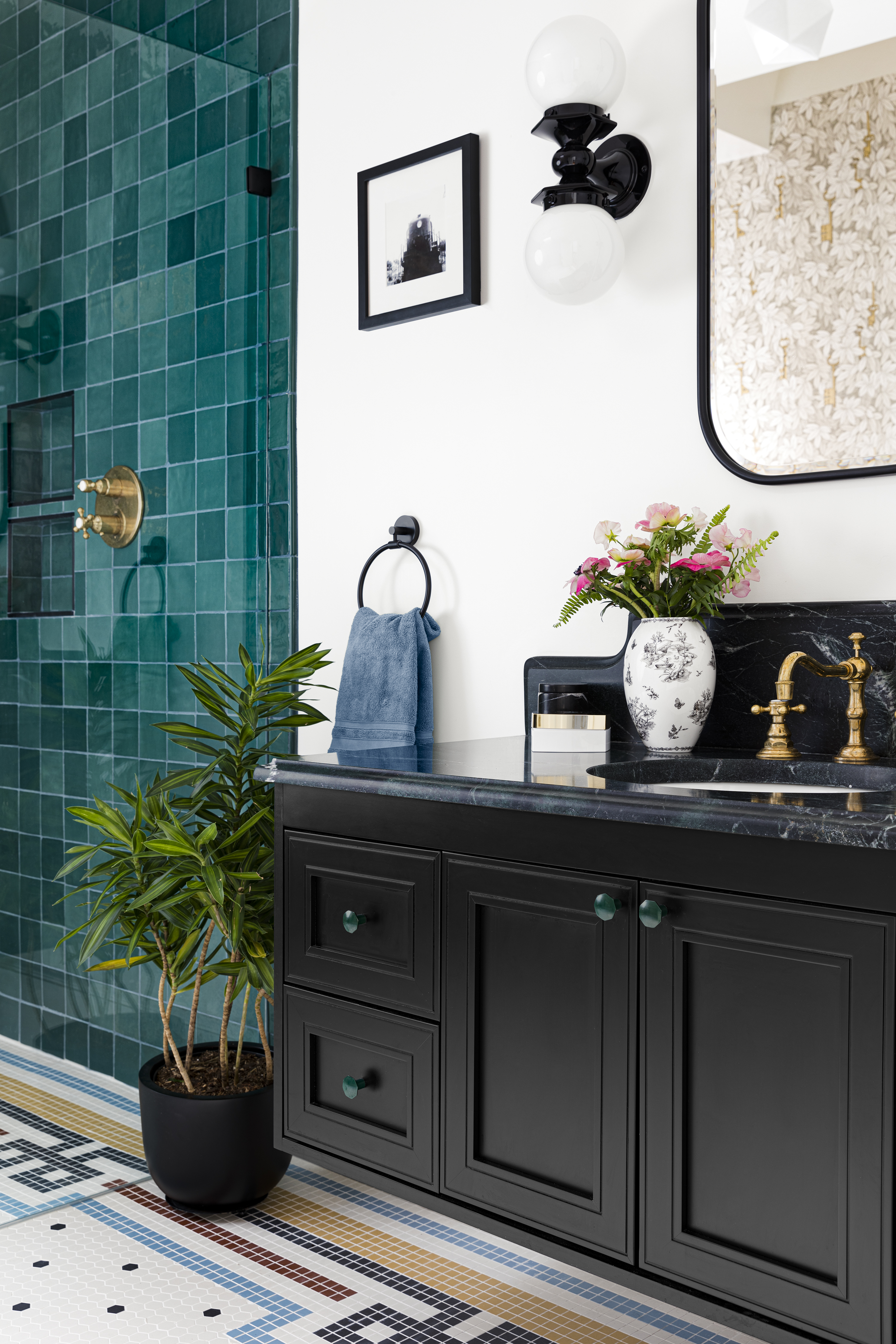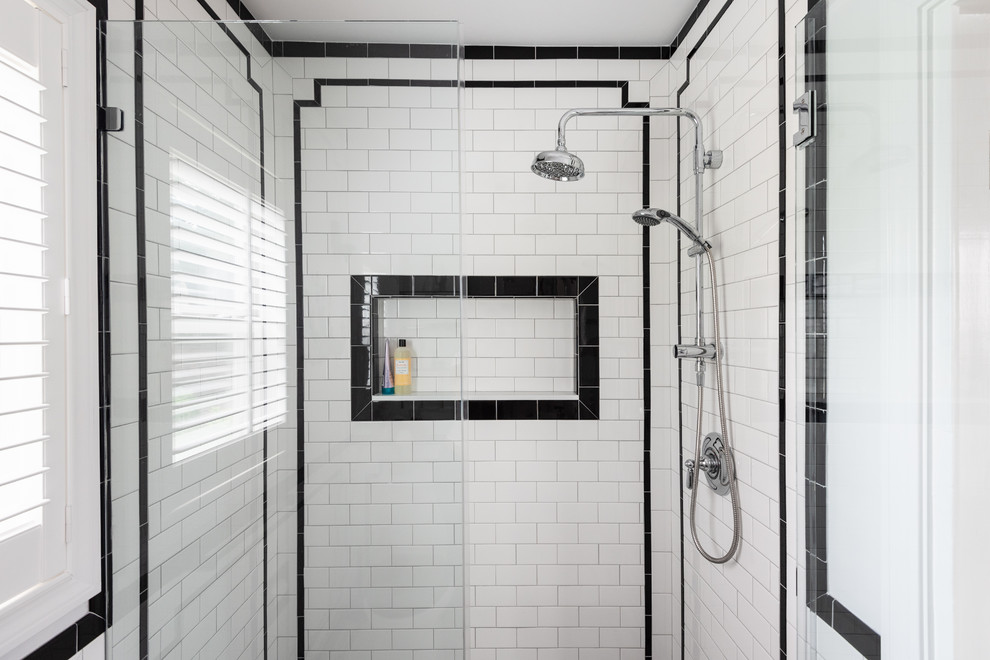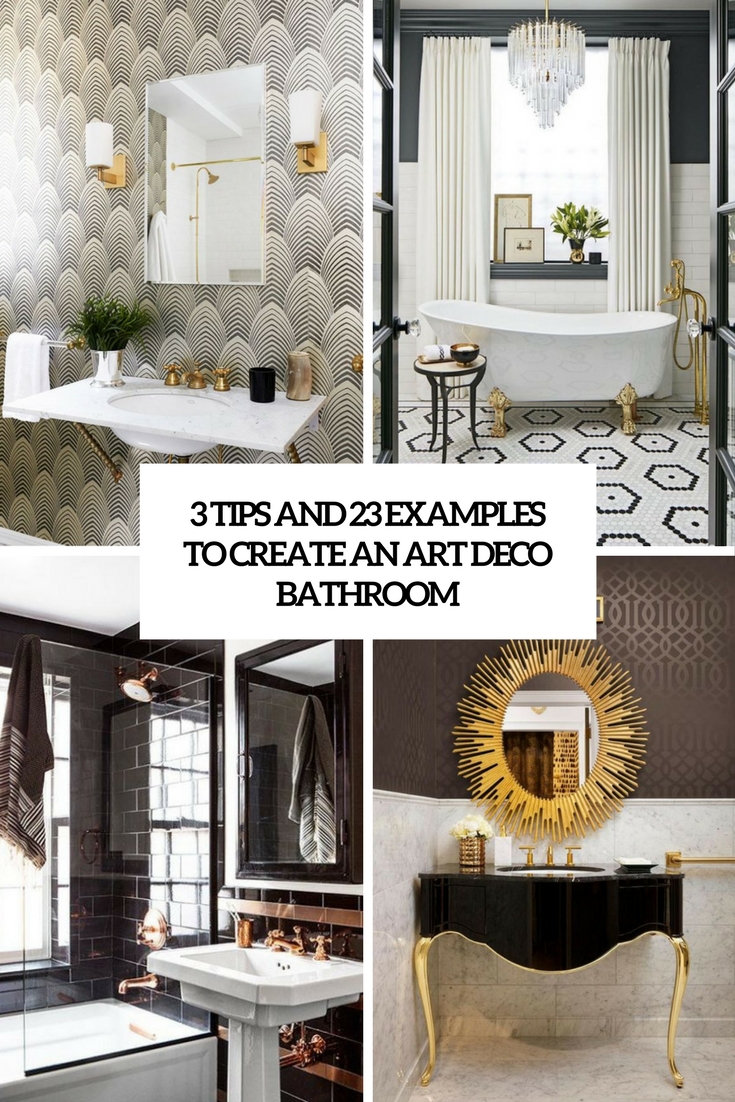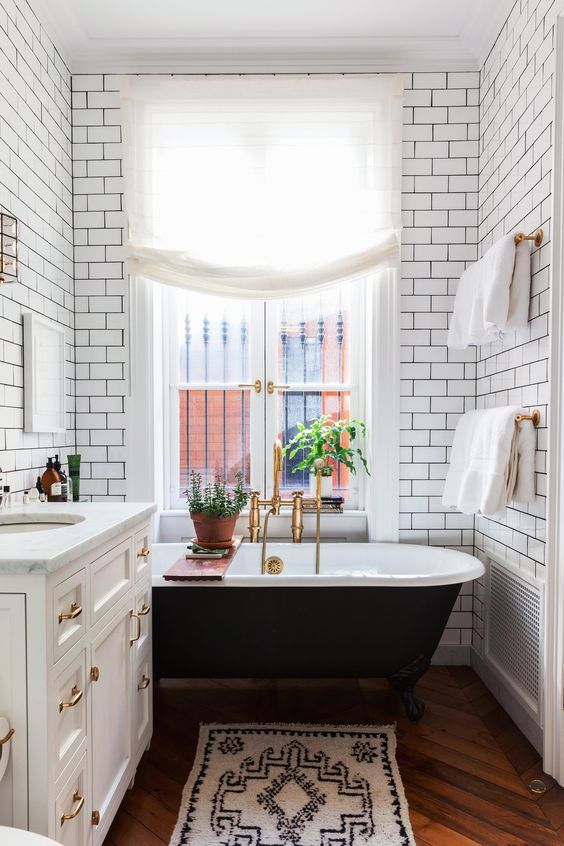The Charms of Art Deco: A Brief Introduction
When I first stumbled upon Art Deco, I was instantly captivated by its bold, glamorous style. Originating in the 1920s and 1930s, Art Deco is an artistic movement that combines modernist styles with fine craftsmanship and rich materials. It represents luxury, glamour, and exuberance, all of which are reflected in the design elements. Stepping into an Art Deco space feels like being transported back to an era where elegance and sophistication were paramount.
One of the most enchanting aspects of Art Deco is its ability to blend various cultural influences. You can see traces of Egyptian, Greek, and Aztec motifs intertwined with futuristic and industrial elements. This unique combination creates a timeless appeal that continues to influence design today. The symmetrical, geometric patterns and bold color palettes of Art Deco are particularly striking in bathroom tile designs, making a simple space feel extravagant.
The beauty of Art Deco lies in its versatility. Whether you have a small, intimate bathroom or a sprawling space, Art Deco tiles can be adapted to fit any size or shape. The use of luxurious materials like marble, glass, and chrome adds a touch of opulence that can elevate the overall aesthetic of your bathroom. The intricate details and craftsmanship of Art Deco tiles make them a true work of art.
Another charm of Art Deco is its emphasis on symmetry and balance. The clean lines and structured designs create a sense of order and harmony, which can be very soothing in a bathroom setting. The repetition of patterns and shapes in Art Deco tiles adds a rhythmic quality to the space, making it feel both dynamic and cohesive. This balance of form and function is a hallmark of Art Deco design.
In my experience, incorporating Art Deco tiles into a bathroom is a fantastic way to make a statement. Whether you choose to cover the entire bathroom with these tiles or use them as an accent, they can instantly transform the space. The bold, eye-catching designs of Art Deco tiles can serve as the focal point of your bathroom, drawing attention and admiration from anyone who enters.
Finally, what I find most charming about Art Deco is its timeless appeal. Despite being rooted in a specific historical period, Art Deco designs continue to feel fresh and relevant. They embody a sense of nostalgia while also looking forward, making them a perfect choice for those who appreciate both tradition and modernity. If you’re looking to add a touch of glamour and sophistication to your bathroom, Art Deco tiles are a fantastic choice.

Key Characteristics of Art Deco Tile Designs
When diving into the world of Art Deco tile designs, several key characteristics immediately stand out. These features are what make Art Deco so distinctive and beloved by designers and homeowners alike. Let’s explore these defining traits in detail.
First and foremost, geometric patterns are a cornerstone of Art Deco design. The use of strong, clean lines and shapes like zigzags, chevrons, and sunbursts creates a visually striking effect. These geometric motifs are not just decorative; they also convey a sense of order and precision. In my bathroom renovation, I opted for a black-and-white chevron pattern that instantly became the focal point of the space. The geometric design added a sense of dynamism and sophistication that I love.
Another characteristic of Art Deco tile designs is the use of bold, contrasting colors. The palette often includes shades like black, white, gold, silver, and vibrant hues such as emerald green and cobalt blue. These colors are used to create high-impact, eye-catching designs that exude luxury and glamour. I found that incorporating a splash of gold tiles among the black and white gave my bathroom a touch of opulence without overwhelming the space.
Art Deco is also known for its use of luxurious materials. Tiles made from marble, glass, chrome, and mirrors are commonly found in Art Deco bathrooms. These materials not only look stunning but also reflect light beautifully, adding to the overall sense of brightness and space. In my bathroom, I chose glass tiles with a metallic finish, which added a shimmering effect that caught the light at different angles.
Symmetry and repetition are other key characteristics of Art Deco tile designs. The tiles are often arranged in symmetrical patterns that create a sense of balance and harmony. This is particularly effective in smaller spaces like bathrooms, where the repeated patterns can make the room feel more cohesive and spacious. I used symmetrical border tiles around the mirror and sink area, which tied the whole look together beautifully.
Ornamentation is another hallmark of Art Deco. This style embraces intricate details and embellishments, from ornate tile borders to decorative inlays. These elements add a layer of richness and complexity to the design. I included some decorative inlays in my shower area, which not only enhanced the overall aesthetic but also added a personal touch that made the space feel uniquely mine.
Lastly, the influence of various cultures is evident in Art Deco tile designs. You can find motifs inspired by Egyptian, Aztec, and Greco-Roman art, among others. This eclectic mix of influences adds a sense of global sophistication and intrigue to Art Deco spaces. For my bathroom, I chose tiles with an Egyptian-inspired motif, which added an exotic flair that complemented the overall design.
Popular Color Schemes in Art Deco Bathrooms
Color plays a crucial role in Art Deco design, and selecting the right color scheme for your bathroom can make all the difference. The bold and dramatic hues associated with Art Deco can transform a simple bathroom into a luxurious retreat. Here are some popular color schemes to consider.
One of the most iconic color combinations in Art Deco is black and white. This classic pairing creates a striking contrast that exudes elegance and sophistication. Black and white tiles can be used to create geometric patterns, checkerboard floors, or sleek borders. In my bathroom, I used black and white tiles in a herringbone pattern, which added a touch of vintage charm while keeping the look fresh and modern.
Another popular color scheme is the use of metallics. Gold, silver, and bronze tiles can add a touch of glamour and opulence to your bathroom. These metallic hues work particularly well as accents, such as in mosaic tiles or decorative borders. I incorporated gold tiles in the shower niche and around the vanity mirror, which added a luxurious feel without overpowering the overall design.
Rich, jewel tones are also synonymous with Art Deco. Colors like emerald green, sapphire blue, and ruby red can add depth and richness to your bathroom. These bold hues can be used as a feature wall, in a mosaic pattern, or as accent tiles. In my bathroom, I chose emerald green subway tiles for the shower wall, which created a vibrant and inviting atmosphere.
For those who prefer a softer palette, pastel colors can also be used in Art Deco bathrooms. Shades like mint green, soft pink, and pale blue can add a touch of vintage charm and femininity to the space. These colors work well with the geometric patterns and luxurious materials typical of Art Deco design. I used pastel pink tiles in a geometric pattern on the bathroom floor, which added a delicate and whimsical touch.
Monochromatic color schemes are another great option for Art Deco bathrooms. Using varying shades of a single color can create a cohesive and sophisticated look. Shades of grey, for example, can add a modern twist to the traditional Art Deco style. In my bathroom, I used different shades of grey tiles in a gradient pattern, which added depth and interest to the space.
Lastly, don’t be afraid to mix and match colors. Art Deco is all about bold and daring choices, so combining different colors can create a unique and personalized look. For instance, combining black and white tiles with a pop of red or gold can add a dramatic flair to your bathroom. In my bathroom, I combined black and white tiles with touches of cobalt blue, which created a striking and memorable design.
Geometric Patterns and Motifs: The Hallmark of Art Deco
When it comes to Art Deco design, geometric patterns and motifs are the true stars of the show. These bold, structured designs are what make Art Deco so distinctive and appealing. Let’s dive into some of the most popular geometric patterns and motifs you can incorporate into your bathroom.
One of the most recognizable geometric patterns in Art Deco is the chevron. This zigzag pattern is both dynamic and visually striking. It can be used in a variety of ways, from floor tiles to backsplashes. In my bathroom, I used black and white chevron tiles on the shower wall, which added a sense of movement and energy to the space. The clean lines of the chevron pattern create a modern and sophisticated look that is quintessentially Art Deco.
Another popular motif is the sunburst. This design features radiating lines that mimic the rays of the sun. It’s a symbol of optimism and energy, making it a perfect choice for a bathroom. Sunburst patterns can be found in tile designs, mirrors, and even light fixtures. I incorporated a sunburst motif in the tile border around my bathroom mirror, which added a touch of elegance and brightness to the space.
The use of stepped forms is another hallmark of Art Deco design. These patterns feature a series of stepped, rectangular shapes that create a sense of depth and dimension. Stepped forms can be used in tile designs, cabinetry, and even architectural elements like door frames. In my bathroom, I used stepped tiles in the backsplash, which added a unique and architectural feel to the space.
Fan motifs are also commonly found in Art Deco design. These patterns resemble the shape of a fan, with radiating lines that create a sense of movement and flow. Fan motifs can be used in floor tiles, wall tiles, and even in decorative elements like mirrors and light fixtures. I used fan-shaped tiles in a mosaic pattern on the bathroom floor, which added a touch of whimsy and sophistication.
Another iconic geometric pattern is the Greek key. This design features a continuous line that loops back on itself, creating a repeating, maze-like pattern. The Greek key is a symbol of infinity and unity, making it a fitting choice for a bathroom. I used Greek key tiles as a border around the bathtub, which added a touch of classical elegance to the space.
Lastly, geometric patterns can be created through the use of tessellation. This involves arranging tiles in a way that they fit together without gaps, creating a continuous, repeating pattern. Tessellation can be used to create intricate and visually stunning designs that add depth and complexity to your bathroom. In my bathroom, I used tessellated tiles in a hexagonal pattern, which added a modern and sophisticated touch to the space.
Materials and Finishes: Choosing the Right Tiles
When it comes to Art Deco bathroom tile designs, the choice of materials and finishes is just as important as the patterns and colors. The right materials can elevate the overall aesthetic and add a touch of luxury to your bathroom. Here are some popular options to consider.
Marble is a classic choice for Art Deco bathrooms. Its natural veining and luxurious feel make it a perfect fit for this glamorous style. Marble tiles can be used on floors, walls, and even countertops. In my bathroom, I chose white marble tiles with subtle grey veining for the floor, which added a sense of elegance and sophistication. Marble is also available in various colors, so you can choose a shade that complements your overall design.
Glass tiles are another popular choice for Art Deco bathrooms. These tiles come in a variety of colors and finishes, including clear, frosted, and mirrored. Glass tiles can add a touch of shine and brightness to your bathroom, reflecting light and making the space feel larger. I used frosted glass tiles in the shower area, which added a modern and sleek look to the space.
Ceramic tiles are a versatile and durable option for Art Deco bathrooms. They come in a wide range of colors, patterns, and finishes, making it easy to find a style that fits your design vision. Ceramic tiles are also easy to clean and maintain, making them a practical choice for bathrooms. In my bathroom, I used black and white ceramic tiles in a geometric pattern on the walls, which added a classic Art Deco touch.
For a touch of glamour, consider using metallic tiles. Gold, silver, and bronze tiles can add a luxurious feel to your bathroom. These tiles are often used as accents or in mosaic patterns to create a high-impact design. I incorporated gold metallic tiles around the vanity mirror, which added a touch of opulence without overwhelming the space.
Mosaic tiles are another great option for Art Deco bathrooms. These small tiles can be arranged in intricate patterns and designs, adding a layer of detail and complexity to your bathroom. Mosaic tiles can be made from various materials, including glass, ceramic, and natural stone. In my bathroom, I used a mix of glass and ceramic mosaic tiles in a sunburst pattern on the shower wall, which became a stunning focal point.
Finally, consider the finish of your tiles. Glossy finishes can add a sense of brightness and make your bathroom feel more spacious. Matte finishes, on the other hand, can add a touch of sophistication and are less prone to showing water spots and fingerprints. In my bathroom, I used a mix of glossy and matte tiles to create a balanced and visually interesting design.
Incorporating Art Deco Tiles into Modern Bathrooms
Incorporating Art Deco tiles into modern bathrooms can create a stunning blend of old and new, resulting in a space that feels both timeless and contemporary. Here’s how you can seamlessly integrate Art Deco elements into your modern bathroom.
Start with a focal point. Art Deco design is all about making a statement, so choose an area of your bathroom to highlight with bold, geometric tiles. This could be a feature wall, the shower area, or even the floor. In my bathroom, I chose to create a feature wall behind the bathtub with black and gold Art Deco tiles in a striking geometric pattern. This instantly drew attention and set the tone for the rest of the space.
Mix and match materials. Combining Art Deco tiles with modern materials can create a balanced and cohesive look. For example, pair classic marble tiles with sleek, modern fixtures, or combine bold, geometric tiles with minimalist cabinetry. In my bathroom, I used Art Deco tiles on the floor and paired them with modern, white subway tiles on the walls. This mix of old and new elements created a harmonious and visually interesting design.
Consider the color palette. While Art Deco is known for its bold and dramatic colors, you can choose a more subdued palette to fit a modern aesthetic. Neutral tones like black, white, and grey can create a sophisticated and timeless look, while still incorporating the geometric patterns and luxurious materials typical of Art Deco design. In my bathroom, I opted for a monochromatic color scheme with black and white tiles, which gave the space a sleek and modern feel.
Use Art Deco tiles as accents. If you prefer a more subtle approach, consider using Art Deco tiles as accents rather than covering entire walls or floors. This could include a decorative border, a mosaic backsplash, or even a few tiles scattered throughout the space. In my bathroom, I used Art Deco tiles as a border around the mirror and sink area, which added a touch of glamour without overwhelming the overall design.
Don’t forget the details. Small touches can make a big difference when incorporating Art Deco elements into a modern bathroom. Consider adding Art Deco-inspired accessories, such as mirrors, light fixtures, and hardware. In my bathroom, I chose a sunburst mirror and chrome fixtures with geometric details, which complemented the Art Deco tiles and tied the whole look together.
Finally, keep it balanced. The key to successfully blending Art Deco with modern design is to strike a balance between the two styles. Avoid going overboard with too many bold patterns or colors, and instead, choose a few key elements to highlight. In my bathroom, I focused on the floor tiles and a feature wall, while keeping the rest of the space more understated. This created a cohesive and harmonious design that feels both timeless and contemporary.
Maintenance Tips for Preserving Your Art Deco Tiles
Maintaining the beauty and integrity of your Art Deco tiles is essential to ensure they continue to shine for years to come. Here are some tips I’ve found helpful in preserving these stunning tiles in my bathroom.
Regular cleaning is crucial. Art Deco tiles, especially those with glossy finishes, can show dirt and grime more easily. I make it a habit to wipe down my tiles with a soft cloth and a mild, non-abrasive cleaner at least once a week. This helps to remove any buildup and keep the tiles looking their best. Avoid using harsh chemicals or abrasive scrubbers, as they can damage the finish and reduce the tiles’ shine.
Pay special attention to the grout. Grout can become discolored and dirty over time, which can detract from the overall appearance of your Art Deco tiles. I use a grout cleaner and a soft brush to scrub the grout lines every few months. Sealing the grout can also help to prevent staining and make cleaning easier. I applied a grout sealer after installing the tiles, and it has made a noticeable difference in keeping the grout looking clean.
Address stains and spills promptly. Accidents happen, but it’s important to clean up spills as soon as possible to prevent staining. I keep a soft cloth and a gentle cleaner on hand for quick clean-ups. For tougher stains, a mixture of baking soda and water can be an effective and gentle solution. Just be sure to rinse thoroughly and dry the tiles afterward to prevent any residue from forming.
Protect your tiles from moisture. Bathrooms are naturally humid environments, which can be tough on tiles. To protect my Art Deco tiles, I ensure proper ventilation by using an exhaust fan and opening windows when possible. This helps to reduce humidity levels and prevent mold and mildew growth. I also use a squeegee to remove excess water from the shower tiles after each use, which helps to keep them dry and free from water spots.
Avoid heavy impacts. While tiles are durable, they can crack or chip if subjected to heavy impacts. I’m careful when handling heavy objects around my tiled areas and use protective mats or rugs in high-traffic areas to prevent accidental damage. If a tile does become damaged, it’s best to replace it as soon as possible to maintain the overall appearance and integrity of the design.
Lastly, periodic professional maintenance can be beneficial. I have a professional tile cleaner come in once a year to give my bathroom a deep clean. They have specialized equipment and products that can remove stubborn stains, polish the tiles, and reseal the grout if needed. This annual maintenance helps to keep my Art Deco tiles looking as beautiful as the day they were installed.
Create An Art Deco Bathroom – DigsDigs
Art Deco Bathroom Ideas Will Make Your Space
Art Deco Bathrooms: A Comprehensive Guide to Styling
Examples To Create An Art Deco Bathroom
Related Posts:








